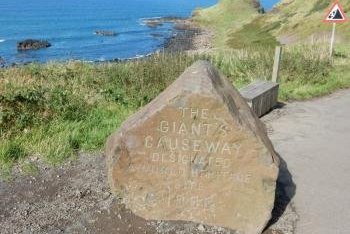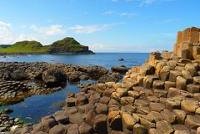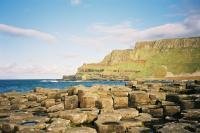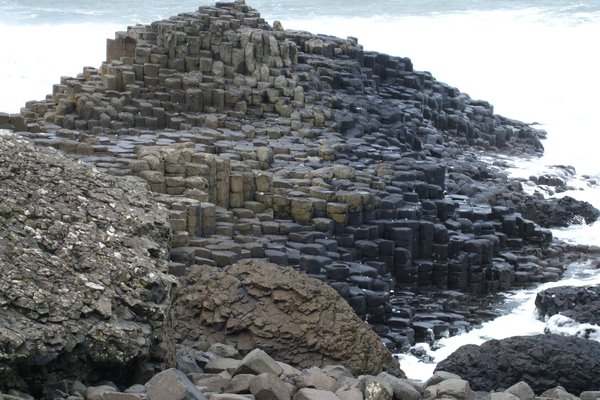United Kingdom
Giant's Causeway
The Giant’s Causeway and Causeway Coast is an important area of study of basaltic volcanism.
The Giant's Causeway is a unique example of columnar jointing with 40,000 interlocking basalt columns resulting from a volcanic eruption. The tops of the mostly hexagonal columns form stepping stones that lead from the cliff foot and disappear under the sea. A succession of lava flows from the Tertiary era can be distinguished along the coast.
Community Perspective: Northern Ireland's most popular attraction and a natural playground for visitors. The area with the ‘steps’ is compact but you can spend hours hiking along the coast. There's also a fairly recent visitor centre. Solivagant has shared all the current practical details to be aware of (and there are many...).
Site Info
Official Information
- Full Name
- Giant's Causeway and Causeway Coast (ID: 369)
- Country
- United Kingdom
- Status
-
Inscribed 1986
Site history
History of Giant's Causeway
- 1986: Inscribed
- Inscribed
- Type
- Natural
- Criteria
- vii
- viii
Links
- UNESCO
- whc.unesco.org
- Official
-
- nationaltrust.org.uk — National Trust
- Related
-
- en.wikipedia.org — The legendary Finn McCool
- giantscausewayofficialguide.com — Link
All Links
UNESCO.org
- whc.unesco.org — whc.unesco.org/
Official Website
- nationaltrust.org.uk — National Trust
Related Resources
- en.wikipedia.org — The legendary Finn McCool
- giantscausewayofficialguide.com — Link
News Article
- Aug. 9, 2025 bbc.com — Area cordoned off at Giant's Causeway after rockfall
- May 29, 2025 bbc.com — Giant's Causeway visitors urged not to jam coins into iconic rocks
- April 9, 2020 countryliving.com — The National Trust introduce grazing cows on the Giant's Causeway for first time in 50 years
- Feb. 26, 2020 news.causewaycoastcommunity.co.uk — Rockfalls and landslides affecting Giant's Causeway
- March 17, 2018 telegraph.co.uk — National Trust accused of 'misleading' tourists into paying for free Giant's Causeway
- March 31, 2016 belfasttelegraph.co.uk — Row after tour guide uses free ancient path to get to Giant's Causeway
- March 2, 2013 belfasttelegraph.co.uk — Green light for a £ 100m golf resort close to the Giant's Causeway
- Oct. 4, 2012 gadling.com — Creationist Audio Tour Removed From Giant's Causeway
- Dec. 27, 2011 bbc.co.uk — Plans for controversial golf resort beside the Giant's Causeway
- Jan. 23, 2010 colerainetimes.co.uk — The long-awaited visitors' centre at Northern Ireland's only World Heritage Site has taken a "giant" step forward, thanks to £ 3m funding from the Lottery
- June 12, 2008 news.bbc.co.uk — Plans to build a £ 18m visitor centre at the Giant's Causeway have been submitted by the National Trust.
- Feb. 10, 2008 news.bbc.co.uk — Environment Minister Arlene Foster has refused an application for a privately funded visitors' centre at the Giant's Causeway.
- Jan. 23, 2008 earthtimes.org — Northern Ireland's only UNESCO World Heritage Site, the Giant's Causeway, is under threat from rising sea levels.
- Sept. 23, 2007 newsletter.co.uk — A decision to allow a private developer to build a visitors' centre on a green field site next to the Giant's Causeway could put its World Heritage Site status at risk.
Community Information
- Community Category
- Natural landscape: Volcanic
Travel Information
Recent Connections
-
Perfect Inscriptions
1986 -
Located in a TCC Territory
Northern Ireland -
INTO Places Program
Connections of Giant's Causeway
- Individual People
- Trivia
-
-
Depicted in Mizielinska Maps
See i.pinimg.com
-
Smallest natural WHS
239.40500 ha (6) -
In Video Games
Assassin's Creed Valhalla; Civilization VI -
On Passports
For anti counterfeiting reasons UK Passports contain pages overprinted with pictures of Giants Causeway (Pages 15 + 42)
-
- Ecology
-
-
Living Stromatolites
See www.bbc.co.uk
-
Columnar Jointing
-
Seals
harbour seal, grey seal
-
- World Heritage Process
-
-
Perfect Inscriptions
1986 -
Minor modifications after inscription
"2016: "extends the boundary of this coastal site by a small distance (5m) inland to account for the possibility of coastal erosion; to address concerns that, should there be significant erosion, the cliff faces, which are key attributes of Outstanding Universal Value (OUV), would no longer lie within the inscribed boundary of the World Heritage property" -
First inscriptions
United Kingdom: seven inscriptions in 1986, with Giant's Causeway and Causeway Coast as the first recorded and with the lowest number
-
- Religion and Belief
-
-
Legends and Folk Myths
Legend of the Irish giant Fionn Mac Cumhaill
-
- Constructions
-
-
Purpose Built Visitor Centre
In Core Zone. 2013
-
- WHS on Other Lists
-
-
Natura 2000
-
Located in a TCC Territory
Northern Ireland -
IUGS Geological Heritage Sites
The Paleocene volcanic rocks of the Giant’s Causeway and Causeway Coast -
INTO Places Program
-
- Timeline
-
-
Paleocene
The Causeway Coast has an unparalleled display of geological formations representing volcanic activity during the early Tertiary period some 50-60 million years ago. (AB ev)
-
- Science and Technology
-
-
Underwater Archaeology
The Site contains a Historic Wreck Site safeguarded under the Protection of Wrecks Act 1973, the Girona. This wreck represents a significant period in European history. On 26th October 1588, the Girona, a galleas of the Spanish Armada, sank of Lacada Point, some three months after sailing from La Corunna. Only 1300 of the 5,00 0 men survived the sinking of the Girona, which is remembered in the name of the bay close to where she sank, Port Na Spaniagh.
-
- Visiting conditions
- Literature & Film
-
-
Poetic Quotations
"Worth seeing, but not worth going to see". Said by Dr Samuel Johnson in 1779 of the Giants Causeway. Reported by James Boswell in "The Life of Samuel Johnson" -
In The Simpsons
“In the Name of the Grandfather” (2009) -
Featured in the Go Jetters
Series 1: Episode 23: Giant's Causeway
-
News
- bbc.com 08/09/2025
- Area cordoned off at Giant's Cause…
- bbc.com 05/29/2025
- Giant's Causeway visitors urged no…
- countryliving.com 04/09/2020
- The National Trust introduce grazi…
Recent Visitors
Visitors of Giant's Causeway
- Adrian
- Adrian Turtschi
- Alberto Rodriguez Gutierrez
- Alexander Barabanov
- Alexander Lehmann
- Alex Baranda
- Alex Goh
- AlexSchedel
- alicemears
- Alikander99
- Ali Zingstra
- ALS
- A. Mehmet Haksever
- Ammon Watkins
- Ana Lozano
- AndreaTLV
- Anne
- Argo
- Artur Anuszewski
- AustralLights
- awestix
- Badwater
- basementonline
- beckyjo27
- Bill Maurmann
- Birgitte Sørensen
- BJGreasly
- BMuramatsu
- Bram de Bruin
- Brendan Carroll
- butterflybird
- c82wc1
- CampbellME
- campmany
- canadiantraveller
- Can SARICA
- Cezar Grozavu
- cflw
- chenboada
- chenqtao
- ChrisN
- Christer Sundberg
- Claire Bradshaw
- ClaraHH
- Clyde
- Col
- Colossus
- Cristina Erba
- Csaba Nováczky
- Daniel Chazad
- Daniel Gabi
- Daniel R-F
- Danny L
- David Berlanda
- Deffra
- Dennis Nicklaus
- Digits
- Dimitar Krastev
- Dimitrios Polychronopoulos
- Dirk-pieter
- Dolemite92
- Don Irwin
- Doubanjiang
- DouglasR
- Dreamcatcher
- edstar500
- Elaine McArdle
- Elena Y
- Elf21
- eljx1988
- Els Slots
- Erik Jelinek
- Eva Kisgyorgy
- Fam39
- Fan Yibo
- Feldhase
- Felicité
- Filip Murlak
- frizzle
- FS
- Garry Jackson
- Gary Arndt
- gautamiyer23
- George Gdanski
- Gernot
- Gilles
- grimloch
- Grzegorz Andruszkiewicz
- Hadrianus
- Hammeel
- Harald T.
- Harry Mitsidis
- H Beswick
- Hdwilsonau
- Hurrvinek
- Iain Jackson
- Ian Cade
- Ilya Burlak
- Ingrid
- Ivan Rucek
- Jacob Choi
- Jacob Otten
- James Bowyer
- janameerman
- janem
- janis
- Jan Zimmermann
- Jarrod_Byham
- Jay T
- Jean Lecaillon
- Jeanne OGrady
- Jezza
- JobStopar
- Joel on the Road
- Jonas Kremer
- jonathanfr
- Jon Eshuijs
- Jonoprout
- JR's HERITAGE SITES
- Just_hatched
- Justin
- jxrocky
- KarenBMoore
- Kasper
- KeithBailey
- Kevin Padley-Knight
- Kjsisney
- Klaus Freisinger
- Krijn
- Kurt Lauer
- kutasp
- Laetitia Yin
- Lara Adler
- LaVale
- leckie118
- Lee Kai Loong
- leroykstlj
- Lillybett
- Linz
- Little Lauren Travels
- Loic Pedras
- lucyannesmith
- Luis Filipe Gaspar
- Lukemarshall
- Maciej Gil
- Maja
- Malgorzata Kopczynska
- Małgosia Łupicka
- Manuelfunk
- Marcobrey
- Mardigny
- Martin
- Martina Rúčková
- maryhattie
- Matejicek
- Matthewsharris
- MH
- MichaelH
- michaelsballard
- Michael Turtle
- Mihai Dascalu
- Mikko
- Mikko Syrjä
- Milan Jirasek
- Ming_9734
- MoPython
- Mstrebl1990
- nan
- Neil McPaul
- NH1984
- Niall Sclater
- Nicole Lampos
- Olli-Pekka Turunen
- opperpco3
- PabloNorte
- Pat Martin
- Patrik
- Patrik_globe
- peacemaker2142
- petar
- Peter Lööv
- Petteri
- pghgeekgrrl
- Philipp Leu
- Philipp Peterer
- Pieter Dijkshoorn
- Piotr Wasil
- Porcho
- puessergio
- Qin Xie
- Randi Thomsen
- Reiseblitz
- Remski
- Reza
- RobRos
- Roel Sterken
- Roger Ourset
- Roman Bruehwiler
- Roman Raab
- Sabrina Liebehentschel
- Samy G
- sandersx2
- Schnitzel
- scubarrie
- Sergio Arjona
- Shandos Cleaver
- sliny
- Solivagant
- Spiceboy
- Squiffy
- Ssong.x
- Stanislaw Warwas
- Sturuss
- Sutul
- Svein Elias
- Szucs Tamas
- Taotao Chen
- Tarquinio_Superbo
- Tatiana Nikulnikova
- Tevity
- TheDarlingLife
- Thomas Buechler
- Thomas Harold Watson
- tingmelvin
- Tom Flaten
- Tommy W
- Tony H.
- travellingcat
- triath
- Truls Brekke
- Tsunami
- Twobaconsandaboston
- Valentina
- valentinaui
- ValiaVeweth
- Van Hung
- vhorne
- Viaje al Patrimonio
- Vincent Cheung
- V&M
- WalGra
- Walter
- Waxwing
- Wimmy
- Wojciech Fedoruk
- Yongcheng Liu
- Zach
- Zoë Sheng
- Александар Стојиљковић
Community Reviews
Show full reviews
Visited June 2025
I do not know what I was expecting before coming to this WHS, but I must admit that I was a bit disappointed because the causeway itself is not so giant (picture, seen from the cliff) , is not so long that the real Irish warrior and hero Fionn mac Cumhaill could use it to cross straight to the Scottland and back. Well, sorry, I should remember that the causeway was destroyed by his Scottish rival… Although not so big, this place is amazing – thousands of basalt columns leading into the sea like magical stairs and the stepping stones disappear under the water. Most of the columns are hexagonal, but you can see some with less or more sides… And the only trace of the giants is the petrified shoe that looks like throne…
During the high tide it can be dangerous to approach to the end of this natural bridge/road. I witnessed an accident – two people were not very careful, lost their balance and fell into the water, hurting and injuring their heads. The ambulance arrived just in couple of minutes.
I visited the site using public transportation. From Belfast International Airport I took a bus to Antrim and then the train to Coleraine where you change to the bus going to Giant’s Causeway Visitor Centre (at least one bus every hour); I skipped the centre and went to the lower path which goes all the way to its end at the lower part …
Keep reading 0 comments
In May 2024 we revisited the Giants Causeway (GC) for the first time in many years. There is a confusing range of logistical/cost options/issues for a visit and, since 6 of the 10 reviews currently here predate the opening of the Visitor Centre (VC) in 2012 which created a new situation, and the others don’t address the options, it seems worthwhile trying to clarify matters as of our visit. I concentrate on those for arriving by car but some will also apply to those traveling by Bus/Train/Coach/Bike.
a. Any visit to the GC itself is free - the beaches and cliff paths are open to all without any payment. The complexities/costs relate to the VC and to car parking.
b. The National Trust’s (NT) large and architecturally stylish modern VC is in a nicely hidden grass-topped building on the cliffs around 1km from the beach where the actual Causeway is situated. Although it might seem so from the positioning of its front doors, this does NOT have to be visited to get to the GC footpaths and, if you do, you will have to pay. Otherwise, just walk round or up and across its grass roof! Each person going inside for ANY purpose has to buy a “Visitor Experience” (VE) Ticket whose price “includes reserved on-site parking, guided tours with our award-winning storytelling team, use of hand-held audio guides, access to the Visitor Centre's exhibition and interpretation area, the shop, café, accessibility aids and …
Keep reading 0 comments
I visited Giant's Causeway in the spring of 2017 by driving half the island of Eire from Dublin to see the unique natural phenomenon. The Causeway is the result of volcanic activity dating back 50-to-60 million of years. The cooling lava shaped itself over time as several clusters of basalt columns of differing height, each no more than a couple of feet in diameter. Most of the columns are hexagonal in shape, but the number of sides can vary between four and eight. In their mass, they look precisely like a causeway for getting into – or out of – the sea. Local legends ascribed its creation to the mythological giant Finn McCool, who was challenged to a fight by an unfriendly giant from Scotland and needed to build a way across the sea for the two of them to meet. Hence, the Giant’s Causeway. On the Scottish island of Staffa there are similar basalt columns, corroborating the folklore. The lively audioguide issued to every paying visitor gets a lot of play out of the legend.
The core of the site, where those basalt clusters are concentrated, is relatively compact, but the surrounding coastal area has miles of trails to explore and offers plenty of other rock formations of interest, from Giant's Boot to Giant's Organ. Budget three to four hours for a proper exploration of the site. If the weather is good, you may decide to extend your stay. It is a unique and incredible site, capable of …
Keep reading 0 comments
Giant's Causeway, in Northern Ireland, exceeds expectations. This geologic formation of hexagonal basalt columns extending into the ocean is a natural playground for visitors, and I had a great time exploring the rocks in September 2015. The same volcanic processes that created these columns also created similar rock formations on the island of Staffa off the west coast of Scotland, and Irish legend has tied the two together with folk tales. On the Irish side, Giant's Causeway is located at the bottom of a hill on the north coast, and when I approached in late afternoon, the waves were crashing loudly against the rocks. The columns spike up at varying levels, creating an uneven surface upon which to walk, but from above, the hexagons appear rather like a giant gameboard for Settlers of Catan. I thoroughly enjoyed spending a couple of hours wandering to and from the ocean along the rock columns, and I am glad Northern Ireland has such a fine location as its only entry on the World Heritage Site list. This is a landscape not to be missed!
Logistics: Giant's Causeway can be reached by a combination of train or bus from either Belfast or Londonderry, but it may be more easily reached by private transportation.
Keep reading 0 comments
I visited the Giant's Causeway as a daytrip by train and bus from (London)derry via Coleraine. You arrive at a huge new visitor centre, and then you can set off to explore the formations on your own or with a guide (quite useful for the background info on the history, nature and geology). I was lucky to visit on a warm and sunny September day, and really enjoyed walking along the shore, admiring the rock formations and tidepools, and of course climbing on some of the rocks. Derry is quite an interesting and historic city, and the train ride along the Antrim coast is really beautiful, plus you can see lots of birds of all types. When you happen to enjoy good weather, this is definitely a fantastic site.
Keep reading 0 comments
i visited this site in 2010 and thought it was a remarkable experience, the rock formations are just so intriguing and wonderful. i did the 6km walk & the walk across the old wooden bridge and i thought that it was the best thing I've ever experience. if you are into geology & history this place is define lay the place for you.
Keep reading 0 comments
I visited this WHS this Summer 2012 by car on a splendid sunny day. I went there early before the crowds and I was practically alone, climbing the hexagonal basalt rocks close to the sea. The Audioguide from the Visitor Centre is very informative and quite interesting. I did the whole trekking trail to The Organ and right to The Chimney where I spotted several Fulmars and Kittiwakkes nesting on the cliffs. The Antrim Coast and Causeway Road are very scenic and on the way back I stopped several times to take incredible pictures. Visit the small fishing towns along the coast for some good food and a pleasant atmosphere.
Keep reading 0 comments
The Giant's Causeway might not be the best-known WHS, but it really is a classic. Already in the late 19th century, it was a tourist site, luring visitors with its exceptional natural beauty. Its peculiar volcanic features have been the center of a scientific debate between Volcanists (who claimed that it was the result of volcanic eruptions) and Neptunists (who pointed to the crystallization of seawater), and still attract geologists from all over the world. Before science, the stones were part of a legend, in which the Irish Giant Finn Maccool built the Causeway as stepping-stones to Scotland to meet his rival Giant Benandonner. And the Causeway was part of the first batch of UK WHS, which means that it was selected earlier than landmarks like Westminster and the Tower of London.
In 2008 the Causeway Coast still is Northern Ireland's most popular tourist attraction. I visited on a stormy Saturday in February when there were about 100 other people scattered around the site. The stretch of coast included in the WHS is about 6 km long. I did the circular walk, starting along the ridge and returning via the road near the coast. This way the most spectacular area (the polygonal basalt blocks) is at the end of the tour. The walking itself is a pleasure also, as you see many other volcanic features along the way. The stormy weather made the waves of the Atlantic Ocean bump into the black rocks with much noise and splatter.
…
Keep reading 0 comments
I visited the Giant's Causeway near Christmas of 2001. Not only was there few people around during that time but what made the experience that much more exciting was that it felt that you were the only person there in a mystical experience between you, the ocean and old Gaelic memories.
It is a bit of a walk up and down from the visitor's centre, but the only time I would recommend it would be when the buses are not running full of tourists.
Keep reading 0 comments
All of Britain's natural World Heritage sites contain coastlines, but this is perhaps the most unique and recognisable of them all. We had a lovely day trip here from Belfast and the whole of the County Antrim coast was very impressive.
The Causeway itself is fairly small, consisting of three small peninsulas of the incredible polygonal columns, these are really impressive and the most accessible and concentrated group of its kind. Everyone that visits seems to climb all over them, and I must admit I had great fun clambering up and down, using the columns as steppingstones.
One interesting aspect about the inscription is that ICOMOS recommended that the site should also be included as a cultural heritage site, due to its role in Irish Legend and also the influence it had on the European Romantic movement. This was never acted on, I guess it is a political decision as it would have meant extending the site to include similar rock formations in Scotland, thus removing the one solely Northern Irish site on the list.
As I said we visited on a day trip from Belfast (a really interesting city oozing with contemporary history), which was a nice easy way to get there. However there are plenty of ways to get to the Causeway from many different locations. The east Antrim coast was especially nice with lots of small fishing villages, which would provide great places to stay for a few nights of rest. Just around the coast from the …
Keep reading 0 comments
After attending a business conference on western Ireland i couldn’t wait to get myself on a bus up to Northern Ireland and the famous Giants Causeway coast line - Northern Irelands only World Heritage Site and a remarkable piece of nature scenery that I’ve been interested in visiting for quite some time.
Spending the day on the bus from Galway to Londonderry and then by train to Colerain on the Northern coast gave me a thorough view of the famous green Irish landscape and the small villages along the way. And when the bus passed the northwestern mountains, with its snow covered peaks, my thoughts went immediately to the Lords of the Ring. And it would not have surprised me a bit if a couple of hobs had hopped on the bus….or maybe the actually did…?
A twenty-minute taxi-ride took ne from Colerain station straight to the Causeway Hotel, opened in 1836 and located right by the coastline cliffs. If you ever decide to visit the Causeway, the Causeway Hotel is an absolute must and just as classical in its own Northern Irelandish way, as Raffels in Singapore or The Ritz in London.
The actual World Heritage Causeway Coast runs further down towards Belfast and includes quite a lot more than the areas north of Bushmill where I went. But it is on the other hand here where you find the classical part and probably the most beautiful and dramatic scenery. It is also here you will find the famous …
Keep reading 0 comments
My daughter & I visited in May 2003. It is an incredible experience. We arrived late in the day so missed visiting the information center but the causeway itself was fabulous and worth every minute getting there. Walking along the coast and climbing the stones allows you to imagine the impact on the lives of all who live & lived near here. Photos don't give you half the idea of how phenominal this site is.
Keep reading 0 comments
